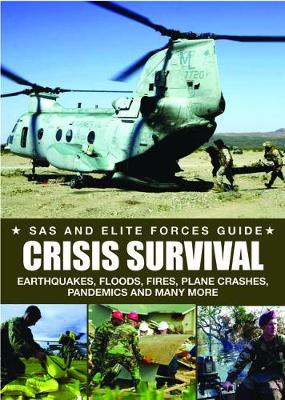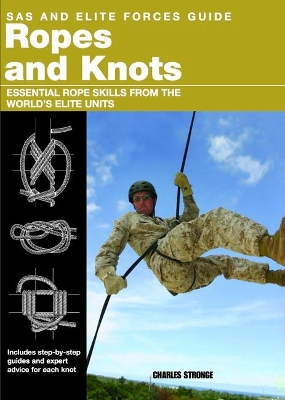SAS and Elite Forces Guide
5 total works
A manhunt can involve helicopters, hounds and hundreds of military or police personnel, but it can also turn on the evidence of one broken spider's web. Manhunts today might involve the technology of infrared cameras and surveillance devices such as powerful satellite technology, but they may also rely on examining the width, depth, tread and intervals of footprints, or observing minute changes in the natural environment.
From searching for high-value enemy targets such as Osama bin Laden and Saddam Hussein to finding soldiers caught behind enemy lines, from escaped prisoners and serial killers to a missing child, Manhunt explores just how the military and police forces track people down. Including many case studies of high-value targets, suspected criminals and fugitives from justice, and with extensive background on the different techniques in tracking used, from traditional Native American trackers'skills to the latest high-tech methods, Manhunt brings together the history and science of tracking. Illustrated with 150 maps and photographs, this book is an authoritative examination of tracking from footprints to forensics and a must for anyone interested in the latest military practices, true crime and survival skills.
About the Author
Alexander Stilwell is an experienced writer and editor who has worked for several leading publishers, primarily in the fields of military history, politics and international affairs. He has also worked for Jane's Information Group and is the author of several books. He served for six years in the British Territorial Army.
From searching for high-value enemy targets such as Osama bin Laden and Saddam Hussein to finding soldiers caught behind enemy lines, from escaped prisoners and serial killers to a missing child, Manhunt explores just how the military and police forces track people down. Including many case studies of high-value targets, suspected criminals and fugitives from justice, and with extensive background on the different techniques in tracking used, from traditional Native American trackers'skills to the latest high-tech methods, Manhunt brings together the history and science of tracking. Illustrated with 150 maps and photographs, this book is an authoritative examination of tracking from footprints to forensics and a must for anyone interested in the latest military practices, true crime and survival skills.
About the Author
Alexander Stilwell is an experienced writer and editor who has worked for several leading publishers, primarily in the fields of military history, politics and international affairs. He has also worked for Jane's Information Group and is the author of several books. He served for six years in the British Territorial Army.
Special Forces in Action: Afghanistan - Africa - Balkans - Iraq - South America
by Alexander Stilwell
Published 1 January 2007
Since the end of the Cold War there have been numerous conflicts and in all of these Special Forces have played a key role. This book examines their activities and operations in numerous theatres from Afghanistan and, Iraq today to the Balkans and Gulf War. Lesser known small wars such as Sierra Leone (and the spectacular rescue of British soldiers by the SAS) and Somalia are also well covered. We learn of long running drug busting operations in Columbia and of current operations pursuing war criminals in the Balkans. In addition there is an introductory chapter tracing the development of SF from their inception in the Second World War with brief descriptions of early operations.
What do you do if your aircraft ditches in the sea? Or your building is on fire? Or you are the victim of a terrorist attack? Would you make the right decision to save yourself and the lives of others? SAS and Elite Forces Guide: Crisis Survival, is a complete handbook to any crisis that may suddenly arise, from food or water shortages, to natural disasters, to plane crashes and hostage situations. A crisis might last a few hours, days, or even years – with this book you can be ready for any eventuality.
With tips and techniques from survival experts, the book is divided into two main sections. The first four chapters deal with learning how to prepare yourself best for disaster. These cover mental strength, physical strength, first aid skills and the use of vital equipment, so that if you find yourself in a crisis, you’re ready. The second section of the book deals with different crisis situations you may face, such as harsh climates and terrain, natural disasters such as floods and forest fires, man-made disasters such as plane crashes and power failures, and terrorist attacks and/or hostage situations.
With more than 300 easy-to-follow artworks and handy pullout lists of key information, SAS and Elite Forces Guide: Crisis Survival is the definitive crisis survival guide for anyone wanting to be ready for anything– it could literally save your life.
About the Author
Alexander Stilwell is a military analyst of many years’experience. He lives near London.
With tips and techniques from survival experts, the book is divided into two main sections. The first four chapters deal with learning how to prepare yourself best for disaster. These cover mental strength, physical strength, first aid skills and the use of vital equipment, so that if you find yourself in a crisis, you’re ready. The second section of the book deals with different crisis situations you may face, such as harsh climates and terrain, natural disasters such as floods and forest fires, man-made disasters such as plane crashes and power failures, and terrorist attacks and/or hostage situations.
With more than 300 easy-to-follow artworks and handy pullout lists of key information, SAS and Elite Forces Guide: Crisis Survival is the definitive crisis survival guide for anyone wanting to be ready for anything– it could literally save your life.
About the Author
Alexander Stilwell is a military analyst of many years’experience. He lives near London.
A simple rope can be a lifesaver in a survival situation. Knowing how to use a rope and make effective knots will help you in an amazing variety of ways, from constructing shelters and creating weapons, to fishing and hunting. Most importantly, ropes and knots act as lifelines in dangerous environments, such as when crossing a fast-flowing river or scaling a mountainside.
The SAS and Elite Forces Guide to Using Ropes and Knots draws on the skills of the world's best soldiers to teach you how to use these essential tools in the wilderness. Tried and tested techniques used by the world's special forces give you expert advice on issues such as how to take care of ropes; the most useful knots to use in a survival situation; how to make your own ropes out of animal tendons or plants; how to use your rope effectively when climbing; and how to lash together a log raft or a shelter.
Including more than 300 illustrations, this guide is easy to understand, packed with expert advice and essential for anyone who wants to know the difference between a reef knot or complex slip knot, and how to make a simple clove hitch, alpine butterfly knot and many more.
About the Author
Alexander Stilwell is an experienced writer and editor who has worked for several leading publishers, primarily in the fields of military history, politics and international affairs. He has also worked for Jane's Information Group and is the author of several books. He served for six years in the British Territorial Army.
The SAS and Elite Forces Guide to Using Ropes and Knots draws on the skills of the world's best soldiers to teach you how to use these essential tools in the wilderness. Tried and tested techniques used by the world's special forces give you expert advice on issues such as how to take care of ropes; the most useful knots to use in a survival situation; how to make your own ropes out of animal tendons or plants; how to use your rope effectively when climbing; and how to lash together a log raft or a shelter.
Including more than 300 illustrations, this guide is easy to understand, packed with expert advice and essential for anyone who wants to know the difference between a reef knot or complex slip knot, and how to make a simple clove hitch, alpine butterfly knot and many more.
About the Author
Alexander Stilwell is an experienced writer and editor who has worked for several leading publishers, primarily in the fields of military history, politics and international affairs. He has also worked for Jane's Information Group and is the author of several books. He served for six years in the British Territorial Army.
Survival Techniques takes you through all the things you need to know about surviving disasters and staying alive in the wild, such as where to find water in the desert; how to build shelters from locally available materials that will keep out the wind and rain but will also be ventilated; what plants are safe to eat and what are deadly poisonous; and what animals will pose a threat in survival situations. In addition to the informative text, Survival Techniques is packed with 150 line diagrams that provide a step-by-step guide to mastering survival situations. Surviving in the wilderness is one thing, but the ultimate aim is to get back to civilisation, and so Survival Techniques contains valuable chapters on navigation techniques and when and how to travel through hostile terrain. Alongside chapters on wilderness first aid, making tools and preserving food in the wild, Survival Techniques also has sections that deal with surviving natural disasters. This book is mandatory reading for those wishing to survive all that nature can throw at them.




